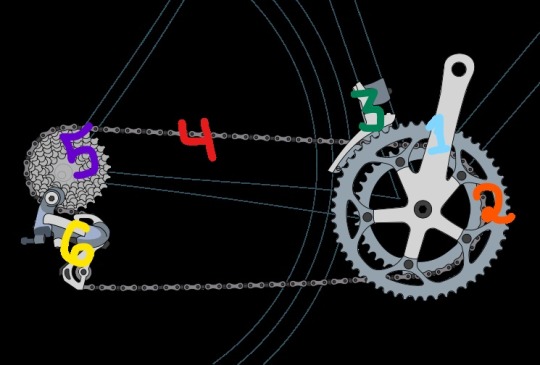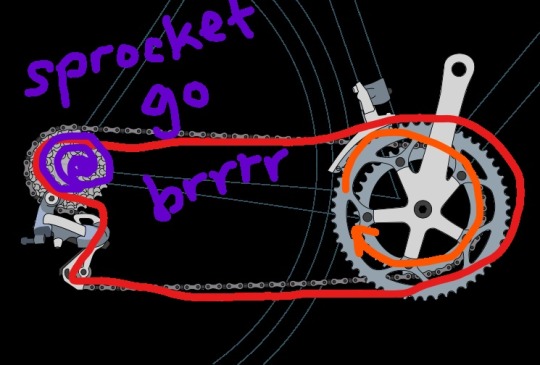#if y'all could use clarification just ask! I know sometimes i make weird leaps that seem logical to me but aren't always to others :3
Explore tagged Tumblr posts
Text
@slytherintothedragonsden and @ciara-jane Many many thanks for the topic suggestion! And I have other reports I’ll have to do, so I’m saving the other topics away as well for those! :3
All right, buckle up folks! By popular demand, we're talking about bicycle gears!
This will probably be more information than any average consumer wants or needs to know, but I had to make it report length, so my apologies! But I'll try to be concise, and I'll do my best to keep the maths to a minimum for those of you sensitive to such things. ;)
The term "gear" or “speed” in this particular context refers to a particular arrangement of toothed wheels, disks, or shafts that translates torque generated by either a motor, someone’s pedaling, or a combination of both, into the physical speed of the bike on the path. Put more simply, a “gear” is a particular “translation” of turns of the crank arms to turns of the back wheel.

So people have more of an idea of precisely what I’m referring to, here on a modern utility/mountain bike chain drivetrain and gear setup:
1. crank arm
2. chainrings
3. front derailleur
4. chain
5. rear sprockets (together also called a cassette, that are attached to the hub of the rear wheel and drive it)
6. rear derailleur
The first bikes only had one “gear” — the pedals and crank arms were affixed directly to the wheel hub. One crank arm revolution equals one wheel turn, one wheel circumference traveled. Incidentally, this is also why penny farthings became a Thing, as ridiculous as they looked and as dangerous as they were — people wanted to get farther with one crank arm revolution, and they were only really limited by the length of their legs and from what height they were willing to risk falling.

Still, gear-less bikes were less than ideal. Issues getting up a hill? Too bad, get stronk. Want to go faster? Pedal faster, lazybones. :P
For the people with a little more common sense or a healthy fear of heights, the “Safety” bicycle (coming to stores near? you in 1886!) got rid of such stupid things as an enormous front wheel, and sat the rider much closer to the ground. More importantly for the development of our modern bicycle transmission, it sat the rider in between the two wheels and used a chain to transfer torque from the pedals to the rear drive wheel.
(For the less physically gifted… physics-ly gifted? torque is force applied over a distance that makes something turn. However, distinguishing between torque and force is more an issue of pedantry and math-ish nerdery than any real key to understanding.)
In the early days, some people came up with the bright idea of putting two different sized cogs or sprockets on the opposite sides of the wheel. Two gears! Too bad you had to stop, get off, remove the rear wheel to flip it around, secure it again, and then get going again in your new gear. This only really became a Thing in racing, where the difference in speed mattered enough to justify that whole song-and-dance.
How does a different-sized rear sprocket make a difference in speed? I’m so glad you asked! (Warning: maths ahead, but I’ll try to make it painless.)
Y’all remember levers, right? (Excuse the terrible Microsoft Paint drawings I made at 11 at night, please.)

You can apply less force at the end of a longer “lever” and have the same effect as if you’d applied more force to a shorter lever. Mathematically, the equation is: F1 x l1 = F2 x l2.
(In the diagrams, F1 is the force of gravity pulling the box down, and F2 is the force exerted by the person, l1 the blue length and l2 the red length. They were originally color-coded like most of the bolded stuff but tumblr didn’t feel like working with me there.)
Now let’s take a look at the rear (driving) wheel of a bicycle. (Proportions exaggerated.)

Y’all see it too, right? Like, uh, either way the torque the chain applies to the sprocket (the blue side of the lever) is on the less advantageous side of the equation (smaller than red), but the larger gear offers a less-bad ratio.
So, why would anyone use a smaller gear? More force actually applied to the wheel on the road is better, right?
Not necessarily. If you’re moving forwards at a good clip, you���re good. If you apply too much force, there’s also the risk of the wheel slipping and losing traction on the road.
Also, I picked the icons I did for a reason. Notice how the larger gear has more teeth? That means it takes a longer length of chain to tug the larger gear around one complete revolution.
What if your chainring has only half as many teeth as your rear sprocket? The teeth are the same distance apart, same chain. That means you have to complete two revolutions of the crank arm to move one rear-wheel-circumference forwards.
There’s an equation for this, too: transmission ratio i = teeth of chainring ÷ teeth of rear sprocket = radius of chainring ÷ radius of rear sprocket = rotations of rear sprocket ÷ rotations of chainring. Any of those three possibilities will get you the same answer.

Note here that the lever principle applies to the pedal and chainrings as well.

In this case, a smaller chainring works in our favor, transferring more torque to the chain and thus to the rear wheel, but less speed.
If we put both of these aspects together, we have the combination small chainring + large rear sprocket giving us the maximum transmission of force from pedals to the rear wheel, but not much forwards speed. Conversely, the combination large chainring + small rear sprocket gives us a lot of forwards speed, but not much force — if we hit a hill we’re going to have a hard time.

Practically speaking: most bikes have two or three chainrings (controlled by the left gear shifter) and between 6 and 10 rear sprockets, though the trend is shifting back to one chainring and many rear sprockets in the super-high-end systems. (Also, with the advent of pedelecs and electric auxiliary motors, most people are now just switching the motor’s boost level instead of shifting chainrings).
To make things more concrete: my bicycle has 8 rear sprockets and 3 chainrings, in bike lingo 3 x 8 gears or speeds. I could say 24-speed, technically, but realistically there’s some overlap in there between different sprocket-chainring combinations, and some combinations I would realistically never use, like small chainring + small rear sprocket, or large chainring + large rear sprocket (not to mention that those kinds of extreme gear combinations can exacerbate chain wear).
On your gear shifters, the thing to remember is: if pedaling is difficult, shift down, to the lower numbers on the left and right displays. The indexing (assigned numbers to cogs) is nicely uncomplicated that way.
I’ve sprung forwards a bit historically, but hopefully that answers the questions of “what even are bike speeds and what do these wizard numbers mean?”
I’ll cut the history and rambling a bit short at this point: in 1930 the predecessor of modern chain-driven gearing systems, the Vittoria Margherita, was invented, and in the 1950s the basic design of modern derailleurs and chain gearing systems popped up, and has stuck around ever since. Shimano did a thing in the 1980s, designing hubs, cassette, pedals, chainrings, front and rear derailleurs, and most components of the drivetrain to specifically work best with the whole set of their parts, which… uh. Like, good that they offer a well-performing, smoothly-designed system, but locking you into buying only their stuff if you want your thing to work right? Not a huge fan. (The corporate side of bikes is. Uh. A whole thing. A whole-ass other ramble.) And now there’s electronic and wirelessly controlled gear shifters, but that’s most of the major developments in gear shifting.
The first widely available transmission system that could be operated without, uhhh, stopping and taking your bike partially apart, was actually an internal gear hub, invented by William Reilly in 1898. It had two (2) different settings. Eventually someone invented the luxury of three-speed hubs!
Internal gear hubs have a different construction, but the principle of the gears are the same: different-sized cogs translate the torque of the chain into more wheel rotations or more applied force to help you get up that damn hill. Nowadays there’s even 14-speed internal hub gears, and an interesting gearbox concept (Pinion is the company) that does the whole translating-through-gears at the bottom bracket and crank arm, entirely between the pedal and chain, instead of between chain and drive wheel.
There’s actually an interesting debate to be had on chain gears versus internal hub gears — they’re both good for different things. Vaguely, internal hub gears are less maintenance-intensive, since most of the mechanism is protected from the elements, but they’re heavier (not the choice of racers). Though you can shift gears at a standstill, you can’t shift if you’re putting much force in the pedals and getting the rear wheel out is a bit more complicated with a hub gear system, if you have a flat. Chain gearing systems are the choice of competitive bikers, generally more efficient at transferring power and offering a broader range of gears.
Hopefully I haven’t offered too much information, or an overwhelming amount. If y’all want clarification on anything, just poke me. :3
Sources:
- I have a 500+ page textbook on all things bicycles. “Fachkunde Fahrradtechnik,” 7th Edition, from the publisher Europa-Lehrmittel if y’all wanna look it up
- Seriously, I’ve been learning this stuff for like 9 months at this point. Theoretically and practically. And I’ll be taking a whole-ass apprenticeship midterm next month. At some point your own education should count for something.
- Also, simple physics.
- A few Wikipedia pages for random references, in particular pertaining to the history of hub gears (and “oh shit what is the thing called in English” moments).
- https://evelo.com/pages/history-of-the-bicycle for a few historical tidbits
- https://bikeradar.com/features/when-were-bicycle-gears-invented/ for more histoical tidbits
- Pictures and icons from Wikimedia, specifically (x) (x) (x) (x), commentary and colorful drawings by me
#rinari rambles#rinari reports#bicycle gears#seriously thank you all so much#you definitely saved my ass#and i had a lot of fun typing this up for you all#and making those shitty memeified drawings#i hope it is actually helpful#if y'all could use clarification just ask! I know sometimes i make weird leaps that seem logical to me but aren't always to others :3
5 notes
·
View notes